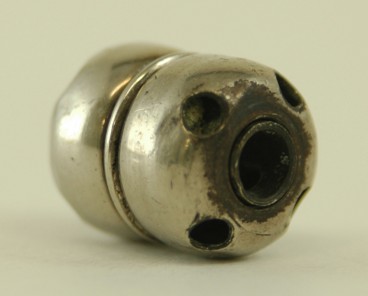Anastomosis button
| ACCESSION NUMBER: | 1962.1.8 |
| Object Name: | Anastomosis button |
| Manufacturer: | unknown |
| Date Made: | circa 1915 |
| MeSH Code: Medical Subject Headings | Surgical Instruments |
ARTEFACT DESCRIPTION
Once called the “surgical genius of our generation” by Dr. William Mayo, Dr. John Benjamin Murphy (1857-1916) was a renowned American surgeon who pioneered techniques in general surgery, orthopedics, cardiothoracic surgery, and neurosurgery. He attached his name to a number of tests and instruments, including Murphy’s sign (a diagnostic for cholecystitis), Murphy’s punch (a diagnostic for gallbladder inflammation), Murphy’s drip (administration of fluids by proctoclysis), and Murphy’s button (for anastomosis).
In 1892 Dr. Murphy devised a tool that, in his estimation, was “going to revolutionize intestinal surgery,” and the treatment of cholecystic disease. Developed in an animal laboratory in his backyard (and used on a human only six days after first being tested on a dog!), Murphy’s button was designed to join hollow viscera, specifically the gallbladder to the intestine, without the use of sutures. The spherical device splits in two, the tissues are affixed each to one half with purse-string sutures, and the halves are snapped back together, holding the tissues together to heal. Murphy reported that his first cholecystoenterostomy took only 11 minutes, reducing operating time tenfold.
The anastomosis button was used in many hospitals into the 1930s and is considered the forerunner to stapling.
Related: Innovation







Leave a Reply